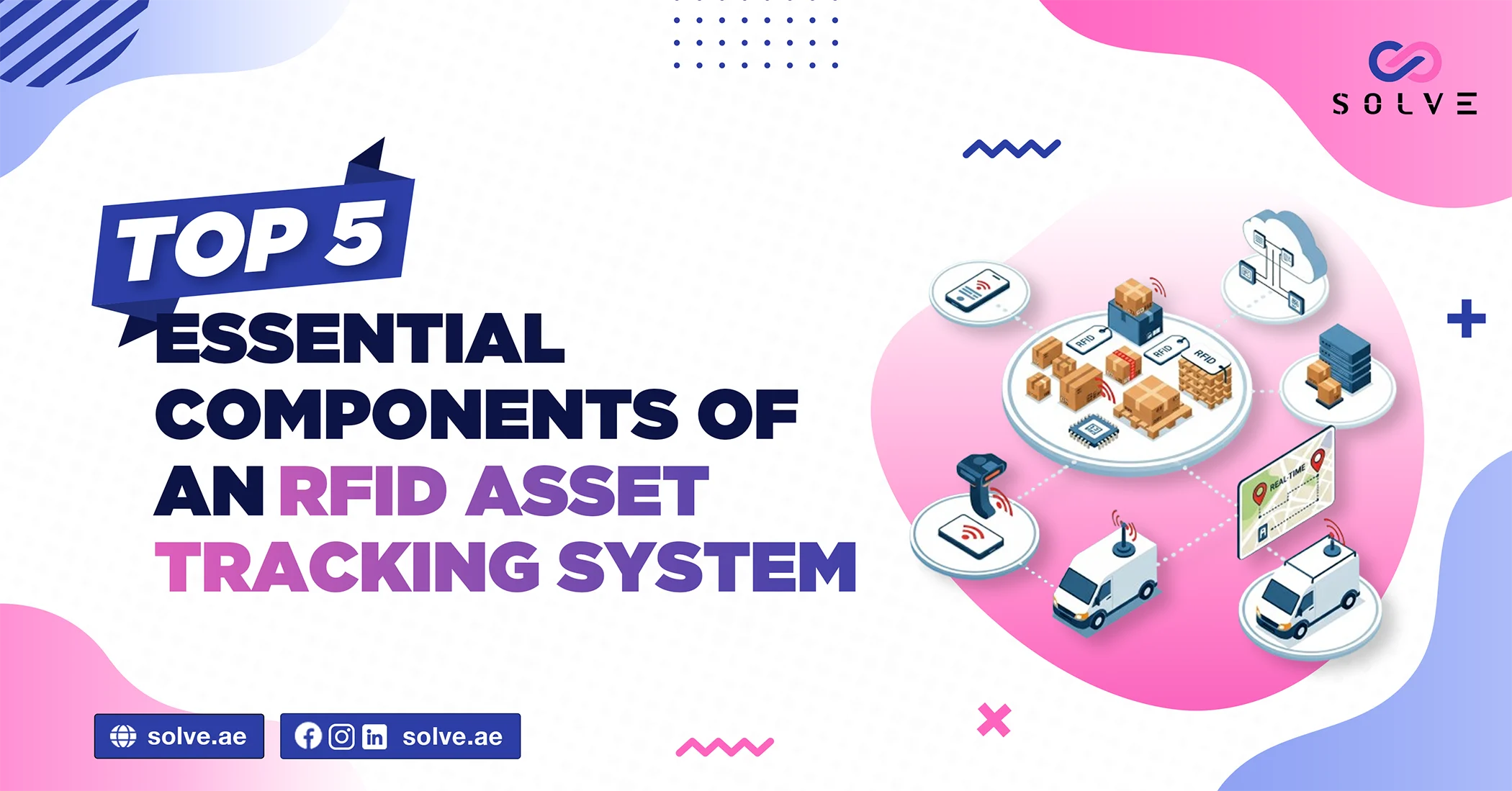- By Vanshika Choudhary
- May 28, 2025
Technology has fully transformed the mechanisms businesses use to track and administer their valuable assets. From warehouses and hospitals to retail stores and construction sites, RFID asset tracking systems afford real-time visibility, thereby limiting human error and expediting operations. But, to take full advantage of the RFID system, one should have knowledge about its main components and how each interacts with the other to achieve seamless asset tracking. In this blog, we will look at the five major components in an RFID asset tracking system and their functions and help you understand why each one is important to your business operation.
RFID Tags
RFID tags are the central piece of any RFID tracking system. These devices attach to the asset, storing information unique to the item they distinguish. No tags mean no tracking!
Types of RFID Tags
There are mainly three types: passive, active, and semi-passive. Passive tags do not have a battery; they draw power from the reader’s signal and are thus very cheap and suitable for short-range tracking. Active tags have a battery of their own to broadcast stronger signals and are therefore useful in tracking high-value assets across large areas like warehouses or construction sites. Semi-passive tags combine aspects of the other two, offering a battery to power the chip but using the reader to communicate, somewhat of a compromise between price and range.
Tag Construction and Durability
Since RFID tags are engineered to resist all forms of environments, some are waterproof and suitable for outdoor or industrial settings, whereas others are thin and flexible enough to be attached to office equipment or inventory items. The durability of a tag should guarantee it if exposed to rough treatment, temperature extremes, and even the chance of getting eaten up by some chemical substances, it will be robust for long-term usage.
Data Storage Possibilities
Each RFID tag processes a unique identifier, although many possess the capacity of containing extra data such as maintenance or service history, asset type, or last service date. This feature is very useful for auditing and compliance industries.
RFID Readers
Combined with RFID tags, RFID readers serve to communicate with those tags and analyze the information stored on them, thereby acting as a bridge between the physical asset and your digital tracking system.
Types of Readers
Handheld readers are portable and good for spot checks and inventory audits. Some systems even integrate readers built into conveyor belts or gateways for completely automated, hands-off tracking and monitoring. Which one you pick depends largely on what kinds of assets you want to track and the environment.
Read Range and Frequency
Dependability of reading range on the power and frequency band used by the reader is one of the significant factors: low-frequency readers are apt for near-range tracking, while UHF readers are capable of collecting tag information from a distance of a few meters. This option allows configuring the system according to the space requirements of either a small office or an expansive warehouse.
The Integration with Other Systems
Modern RFID readers may have options for connectivity, including Wi-Fi, Bluetooth, or Ethernet. They also integrate with other business systems for inventory management or ERP software, helping automate workflows and lower manual data entry.
Antennas
Antennas are extremely critical to the communication alliance between the RFID tag and the RFID reader. This determines how well the system tracks the assets in question and the distance that it tracks.
Placement and Coverage of Antennas
Proper positioning of antennas will ensure that all moving assets are tracked. For example, in the warehouse, antennas can be placed at loading docks, at entry doors, or on conveyor belts. Strategic placement will ensure that there are no blind spots wherein assets will be lost track of.
Types of Antennas
There are linearly and circularly polarized antennas, each suited for various situations. Circular antennas are fine for environments where the orientation of tags is random, such as a busy storeroom. Having the correct type ensures fewer missed assets and reliable reads.
RFID Asset Tracking Software
A system controller is considered the “brain” of your RFID system, storing data, processing it, and displaying information so that raw reads from tags can be turned into actionable information for your business.
Data Management and Processing
In real-time, it updates the status of various assets, providing users with a view of their inventories. Once automation takes its place, many manual processes will be eliminated, and human error will be reduced, thereby improving the efficiency of your asset management.
Reporting and Analytics
The RFID system empowers manufacturers and warehouses with the tracking of employed assets, systems to identify bottlenecks, and tools to analyze changes over the run of time. Analyzing trends can show if certain tools To help make better business decisions, one can find out if inventory levels are too low.
Integration with enterprise systems
Also, Integration with ERP systems, warehouse management, or maintenance is offered by many RFID software solutions. Integration facilitates workflow and maintains data consistency, so users need not enter similar data twice. check out our latest blog post Passive vs. Active RFID Tags: Choosing the Right Solution for Your Assets
Backend Database and Middleware
From the backend database and middleware, your RFID system derives its backbone, so it provides safe data storage, which makes it accessible when needed.
Centralized Storage of Data
The centralized database stores all the asset information, movement history, and system logs. This makes it easy to audit, generate compliance reports, or analyze asset performance over time. Centralization also means that up-to-date information is available to everyone in the organization.
Middleware for Filtering of Data
The middleware acts as a filter between the readers and the main software. It will clean the raw data, remove duplicates, and handle exceptions before forwarding only reasonable information to the database. Doing this keeps the system tidy and free from data that is stale or fraudulent.
Security and Access Control
The security features, such as user authentication, role-based access, and data encryption, secure sensitive asset information. Only those authorized can view or modify the data, hence eliminating theft or tampering of records and data features, especially needed for industries bound by regulatory requirements.
Conclusion
The success of an RFID asset tracking system relies upon its seamless integration of tags, readers, antennas, and software, as well as a secure backend database. Each component contributes to delivering accurate, real-time visibility and efficient asset management. If you are looking at getting your asset tracking upgraded or geared towards assisting you with the right RFID solution for your business, do contact us today. Our experts will stand by your side through everything and ensure maximum value is thrown into the investment.




